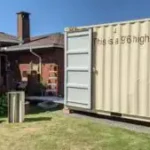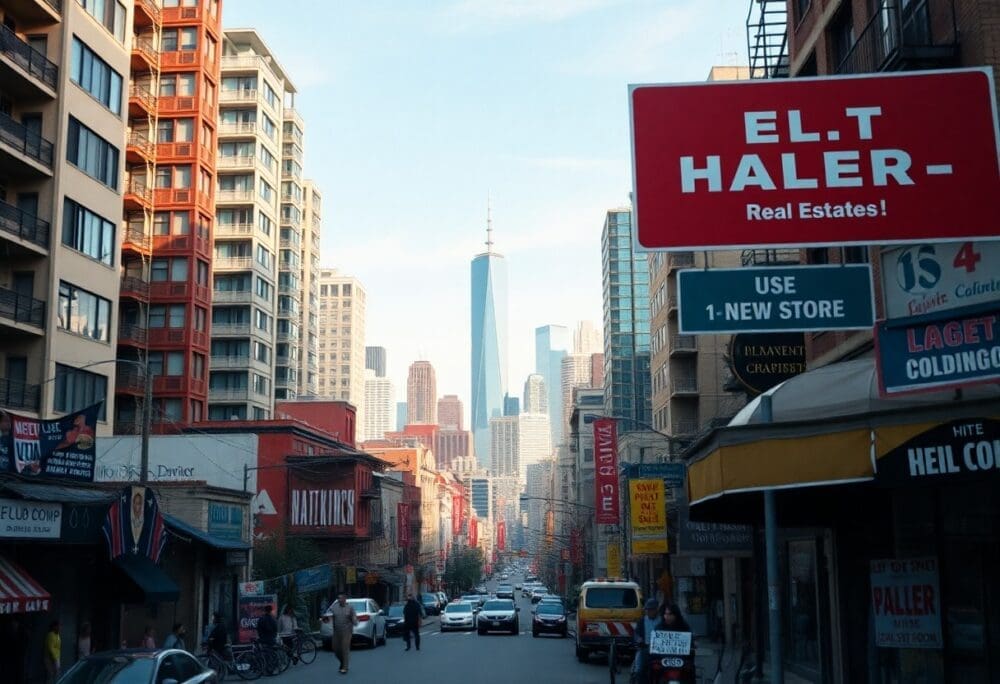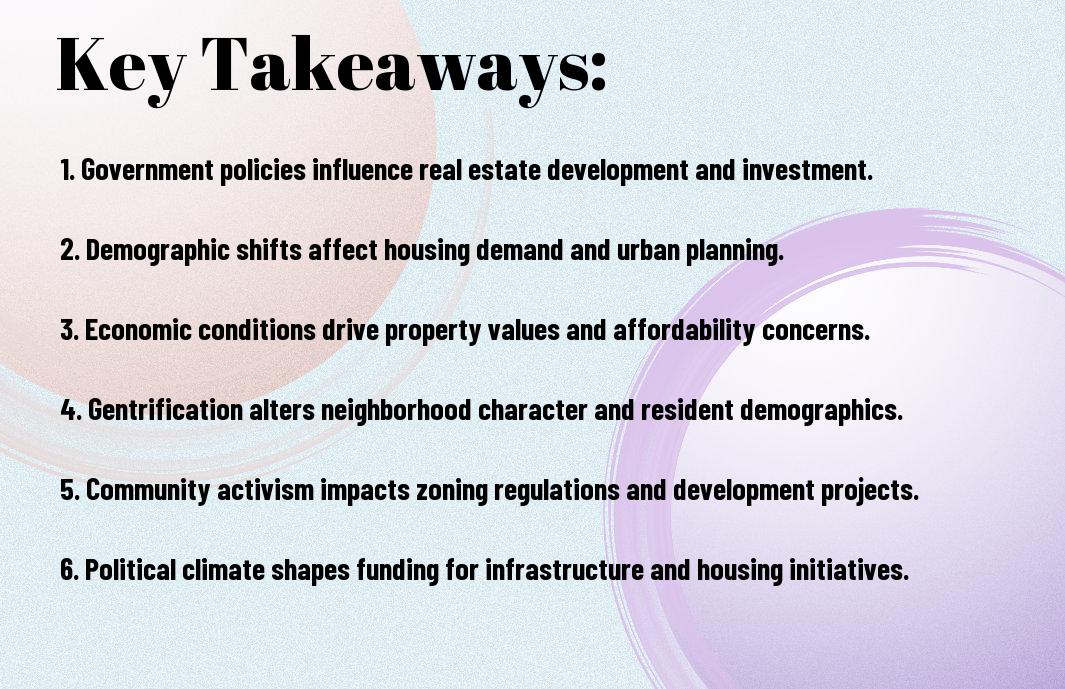In real estate, understanding the interplay between sociopolitical dynamics and urban trends is important for making informed investment choices. As you navigate this complex landscape, the influence of local governance, community demographics, and socioeconomic policies will become apparent in property values and demand. By analyzing these factors, you can better anticipate shifts in the market, ensuring that your investments align with broader societal changes. This post will explore how various sociopolitical elements sculpt urban real estate patterns, providing you with the insights needed to thrive in this ever-evolving sector.
Key Takeaways:
- Sociopolitical factors, including government policies, zoning laws, and community activism, significantly influence real estate development and investment in urban areas.
- Demographic shifts, such as migration patterns and changing socioeconomic conditions, directly impact housing demand and affordability in cities.
- The interplay between local governance and private sector interests can create disparities in urban revitalization efforts, affecting equity and access to housing.
Understanding Sociopolitical Dynamics
The sociopolitical landscape is fundamental in shaping urban real estate trends. Factors such as government policies, community engagement, demographics, and economic conditions interplay to influence property values and development opportunities. By understanding these dynamics, you can better navigate the complexities of urban real estate markets and make more informed investment decisions.
Historical Context
An exploration of urban real estate trends begins with recognizing their historical context. Over the decades, various sociopolitical events, such as economic recessions, civil rights movements, and urban planning initiatives, have significantly influenced the development landscape. By assessing past patterns, you can gain insights into current trends and anticipate future shifts in the market.
Current Influences
Behind today’s urban real estate trends lie several current influences, including government regulations, zoning laws, and shifts in demographics. These factors can dictate what types of developments are feasible, affecting everything from housing availability to commercial space utilization. You’ll want to stay updated on these dynamics to identify potential opportunities or challenges in your investments.
Further analysis of current influences reveals how socio-economic factors, such as workforce mobility and remote work trends, are reshaping urban environments. As more people seek housing in suburban areas or prioritize access to amenities, you may observe a shift in property demand. Additionally, public policies aimed at sustainability can affect development incentives, pushing investors to adapt to meet these evolving expectations. By keeping a keen eye on these trends, you can better position yourself within the dynamic world of urban real estate.
Urban Real Estate Trends
If you’re observing shifting patterns in urban real estate, you’re not alone. The interplay of sociopolitical factors has led to dramatic transformations in how cities are developed and how properties are valued. Understanding these trends is vital for anyone looking to make informed decisions in the urban property market.
Market Demand and Supply
Behind every urban real estate trend lies the dynamic relationship between market demand and supply. As sociopolitical conditions evolve—such as changes in population demographics, economic policies, and community engagement—demand for housing and commercial spaces fluctuates, ultimately influencing the overall availability of properties in urban areas.
Property Values and Investment Patterns
After assessing the broader market, you may notice that property values reflect the sociopolitical climate. Areas experiencing revitalization often see increased investment, while those facing political instability may struggle to attract buyers. Your investment strategies should consider these factors to optimize your portfolio.
Considering the intricate relationship between property values and sociopolitical dynamics is key to successful real estate investment. Factors such as local governance, immigration policies, and public infrastructure initiatives can directly influence property desirability and prices. By staying informed about these elements, you can make strategic decisions that align with market trends and your long-term investment goals.
Policy Impacts on Urban Development
Keep in mind that urban development is heavily influenced by various policies implemented at local, state, and federal levels. These policies dictate the framework within which developers and investors operate, shaping the landscape of your community in ways that can either facilitate or hinder growth and investment opportunities.
Zoning Laws and Regulations
With urban areas constantly evolving, zoning laws and regulations play a significant role in dictating land use, building heights, and density restrictions. These legal frameworks affect not just where you can build, but also how properties are valued and what types of developments are feasible in your neighborhood.
Government Initiatives and Incentives
Urban development is often driven by government initiatives and incentives that encourage investment in specific areas. These may include tax breaks, grants, or funding for infrastructure improvements that can enhance property values and attractiveness for investors.
A well-designed government initiative can serve to revitalize underdeveloped neighborhoods, providing the necessary resources to transform them into thriving residential or commercial hubs. For you, this means that participating in developments within these areas can yield significant returns, while also contributing positively to your community. Engaging with local incentives not only benefits you financially, but it helps foster a more vibrant urban environment for everyone.
Social Issues and Urban Real Estate
For many urban residents, social issues significantly influence the real estate landscape. As cities evolve, you may find that factors such as income inequality, education disparities, and crime rates play a pivotal role in shaping property values and investment opportunities. Understanding these social dynamics allows you to navigate the real estate market more effectively, ensuring you make informed decisions that align with broader community trends.
Gentrification and Displacement
Beside changing neighborhood demographics, gentrification brings significant challenges, particularly regarding displacement of long-term residents. As property values increase, you may notice that affordable housing options dwindle, pushing lower-income families out of their communities. This trend often leads to social tensions, as established residents face the dilemma of being priced out of their own neighborhoods.
Affordability Crisis
Below the surface of urban growth, an affordability crisis looms large, impacting your options as a potential homeowner or renter. The increasing cost of living, coupled with stagnant wages, places immense pressure on your ability to secure housing that fits your budget. Urban centers are struggling to maintain a balance between attracting investment and ensuring accessible housing for all socioeconomic groups.
This affordability crisis is not just a statistic; it affects real lives, including yours, as housing insecurity becomes increasingly prevalent. Cities grapple with rising rents and a lack of affordable housing developments, compelling local governments to consider policy interventions. As you interact with the real estate market, understanding this crisis will empower you to make choices that align with your financial well-being while advocating for sustainable solutions within your community.
The Role of Community Activism
After urban neighborhoods undergo change, community activism often plays a pivotal role in shaping real estate trends. Local residents organize to voice their concerns, advocate for their needs, and champion sustainable development initiatives. By rallying community support, activists influence land use policies, zoning regulations, and funding allocations, ultimately impacting property values and neighborhood vitality.
Grassroots Movements
Activism at the grassroots level is important in mobilizing individuals who share common interests and goals. These movements focus on engaging local residents, fostering unity, and amplifying voices that might otherwise remain unheard. By organizing protests, community meetings, and informational campaigns, grassroots activists can effectively challenge harmful real estate developments and promote equitable housing solutions.
Collaborative Urban Planning
One effective way communities shape their urban landscapes is through collaborative urban planning initiatives. These approaches encourage inclusive dialogues between residents, government officials, and developers, ensuring that everyone’s perspectives are considered in the planning process.
A collaborative urban planning effort prioritizes community input, allowing you to actively participate in decisions about the future of your neighborhood. By engaging in workshops, public forums, and surveys, you can help define desired outcomes, support sustainable development, and express concerns over potential gentrification. This shared responsibility fosters a sense of ownership and investment in your community, ensuring that real estate trends reflect the unique needs and aspirations of local residents.
Global Perspectives on Urban Real Estate
Now, you should consider how urban real estate trends are influenced by sociopolitical dynamics globally. Cities around the world are witnessing transformations driven by policies and environmental factors that shape the market. For deeper insight, explore The impact of urban planning on the real estate market, which highlights the interplay between planning and real estate outcomes.
Case Studies from Major Cities
Below, you will find notable examples illustrating urban real estate trends:
- New York City: Post-pandemic rental prices decreased by 15%, highlighting shifts in demand.
- Tokyo: With the 2020 Olympics, housing prices surged by 20% in key districts.
- London: Brexit resulted in a 10% decline in investment from overseas, affecting annual growth.
- Beijing: Government policies promoted affordable housing, leading to a 12% increase in low-income ownership.
- Berlin: Rent control measures saw a stabilization of rental prices post-2020.
Lessons Learned Across Borders
From various global examples, you can derive valuable insights into urban real estate dynamics.
Studies show that adaptable policies in urban planning can significantly mitigate negative impacts during economic downturns. You can benefit from observing how different regions implement strategies, such as affordable housing initiatives in Berlin and proactive zoning laws in Tokyo, to maintain a balanced real estate market. By recognizing these global lessons, you can better inform your own understanding of urban dynamics and real estate investments.
Final Words
Presently, understanding how sociopolitical dynamics influence urban real estate trends is necessary for you as an investor or homeowner. The interplay of policies, community values, and economic shifts directly impacts property values and market demand. By staying informed about local governance, demographic changes, and social movements, you can make more strategic decisions, ultimately enhancing your position in the evolving urban landscape. Your awareness of these factors will empower you to navigate challenges and seize opportunities in the real estate sector effectively.
Q: How do government policies influence urban real estate trends?
A: Government policies play a significant role in shaping urban real estate trends. Zoning laws, tax incentives, and development regulations can either encourage or restrict certain types of developments. For instance, cities that implement flexible zoning laws may see a surge in new constructions, like mixed-use developments, which blend residential and commercial spaces. Conversely, stringent regulations can stifle growth by making it difficult to obtain permits or requiring costly compliance efforts. Additionally, government initiatives aimed at affordable housing can lead to increased investment in specific neighborhoods, thereby impacting real estate values and market demand.
Q: In what ways do social movements affect urban real estate markets?
A: Social movements can significantly impact urban real estate markets by shifting public opinion and influencing policy changes. For instance, movements advocating for environmental sustainability often promote green building practices and the development of eco-friendly neighborhoods. This shift in focus can lead to a rise in demand for sustainable housing options. Furthermore, social equity movements can bring attention to issues such as gentrification, prompting local governments to adopt policies that protect vulnerable populations from displacement. As a result, areas experiencing a resurgence may see changes in real estate prices and demand based on the community’s priorities.
Q: How does population migration affect urban real estate trends?
A: Population migration plays a fundamental role in determining urban real estate trends. Influxes of people, whether due to job opportunities, lifestyle choices, or climate impacts, can lead to increased demand for housing in certain areas. For example, a significant migration of professionals to a tech hub city might drive up demand for both residential and commercial properties, leading to increased prices and rapid development. Additionally, demographic shifts, such as aging populations or young professionals seeking affordable housing, can influence the type of developments that are prioritized in urban planning. These trends often result in both revitalization of certain neighborhoods and the decline of others that may lack the same appeal or amenities.






